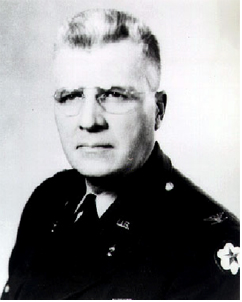Brigadier General
Thomas K. Vincent
 During his long
military career as an officer of the Army Ordnance Corps, General Vincent served with distinction in
assignments of broad responsibility during World War I, World War II, the Korean War, and through all the
intervening years. His technical experience in artillery design, proving ground administration, and rocket
and missile development was unusual. No other officer in the long and memorable history of Army Ordnance
served in such field with greater vigor or had more widespread responsibility.
During his long
military career as an officer of the Army Ordnance Corps, General Vincent served with distinction in
assignments of broad responsibility during World War I, World War II, the Korean War, and through all the
intervening years. His technical experience in artillery design, proving ground administration, and rocket
and missile development was unusual. No other officer in the long and memorable history of Army Ordnance
served in such field with greater vigor or had more widespread responsibility.
As a young Field Artillery officer, he served during World War I at Fort Leavenworth, Kansas, and Fort Sill, Oklahoma, followed by duty in the Philippines. The Field Artillery of those days offered little opportunity for an honor scholar in engineering, so Lieutenant Vincent transferred to the Ordnance Corps in July 1920. After a brief indoctrination, he served at Frankford Arsenal, Philadelphia, and later as the Adjutant, Raritan Arsenal, New Jersey. In 1924, he was assigned to the important post of Ordnance Officer for the Camp Perry, Ohio, National Matches.
In 1925, the General launched on his advanced 2-year technical course at the Ordnance School at Watertown Arsenal, then under the famous Colonel Tracy Dickson. The greater part of the curriculum was conducted at the Massachusetts Institute of Technology, supplemented by practical work at Watertown. He remained at this arsenal for 4 more years as officer in charge of the Cold Working Division.
In 1931, General Vincent entered the Army Industrial College, Washington, D.C. After graduation in June 1932, he started his first assignment in the Office, Chief of Ordnance, being assigned to the Artillery Division of the Manufacturing Service. During this assignment, he directed the activity that pioneered in America the development of the process for strengthening cannon by radial expansion under hydraulic pressure. This process greatly improved the overall strength and endurance of the cannon tubes. After 3 years of concern over procurement of artillery with the meager funds available, the General was transferred to the Proof Division at Aberdeen Proving Ground, Maryland. Following this, he returned to the Office of the Chief of Ordnance for a tour as chief of the Small Arms and Small Arms Ammunition Division, and then went to the Hawaiian Department as Assistant Ordnance Officer.
The gathering clouds of war abruptly curtailed the General's duty in Hawaii. He was recalled to the United States in December 1940 and given the task of building and commanding the Erie Proving Ground at Lacarne, Ohio, where practically all World War II artillery and tank armament received final acceptance tests. With Erie in full-scale operation the General was transferred back to the Office of the Chief of Ordnance in Washington in August 1942 for another long tour. He was successful as the Executive Assistant to the Chief of Field Service, Assistant Chief of the Production Service Division, and the Chief of Redistribution and Salvage. Thus, during World War II he carried a tremendous workload in connection with the heavy output of armament required by our armies throughout the world.
In February 1946, the General was appointed production manager of the Springfield Armory, followed by a detail in Europe as Special Assistant to the Chief of Ordnance, European Command, and later as Commander of the Ordnance Depot, Griesheim, Germany. December 1948 found him back in proving-ground activities, this time as Deputy Commander of Aberdeen. In June 1951 he was promoted to Brigadier General and given additional duty as Commanding General of the Ordnance Training Command just as rapid increases in trained Ordnance officers were demanded to meet the expanding requirements of the Korean War.
In June 1952, General Vincent was appointed Commanding General of Redstone Arsenal, Huntsville, Alabama. Here, he was in the thick of development of the Army's first generation of Ordnance rockets and guided missiles, and saw the first two systems into the deployment phase--the NIKE AJAX antiaircraft missile in March 1954 and the HONEST JOHN rocket in June 1954. The missile systems then under development were the CORPORAL, LACROSSE, REDSTONE, HAWK, and NIKE HERCULES. In addition to directing the development of Army rockets and guided missiles, General Vincent oversaw the production of chemical artillery ammunition for the U.S. Armed Forces at the height of the Korean War.
From Redstone Arsenal, General Vincent retired on 31 August 1954, after 37 years of devoted commissioned service. In keeping with his vast interest in and knowledge of ordnance and his lifelong attachment to the American Ordnance Association, he became staff consultant for the Technical Divisions and Committees of the Association at national headquarters in November 1954.
In his brief 2 years as guide and mentor for the widespread American Ordnance Association Technical Divisions and Committees, General Vincent's friendly and tactful approach to the problems within the armed services continued to cement the close relationship of industry and the services.